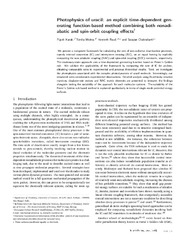Blar i forfatter "Chakrabarti, Swapan"
-
Anomalous phosphorescence from an organometallic white-light phosphor
Paul, Lopa; Chakrabarti, Swapan; Ruud, Kenneth (Journal article; Tidsskriftartikkel; Peer reviewed, 2017-09-25)We report theoretical results on the possible violation of Kasha’s rule in the phosphorescence process of (acetylacetonato)bis(1-methyl-2-phenylimidazole)iridium(III), and show that the anomalous emission from both the T1 and T2 states is key to its white-light phosphorescence. This analysis is supported by the calculated Boltzmann-averaged phosphorescence lifetime of 2.21 μs, estimated including ... -
Behind the scenes of spin-forbidden decay pathways in transition metal complexes
Moitra, Torsha; Karak, Pijush; Chakraborty, Sayantani; Ruud, Kenneth; Chakrabarti, Swapan (Journal article; Tidsskriftartikkel; Peer reviewed, 2020-11-10)The interpretation of the ultrafast photophysics of transition metal complexes following photo-absorption is quite involved as the heavy metal center leads to a complicated and entangled singlet–triplet manifold. This opens up multiple pathways for deactivation, often with competitive rates. As a result, intersystem crossing (ISC) and phosphorescence are commonly observed in transition metal complexes. ... -
Demystifying the Origin of Vibrational Coherence Transfer Between the S1 and T1 States of the Pt-pop Complex
Karak, Pijush; Ruud, Kenneth; Chakrabarti, Swapan (Journal article; Tidsskriftartikkel; Peer reviewed, 2021-10-01)We demonstrate that spin-vibronic coupling is the most significant mechanism in vibrational coherence transfer (VCT) from the singlet (S<sub>1</sub>) to the triplet (T<sub>1</sub>) state of the [Pt<sub>2</sub>(P<sub>2</sub>O<sub>5</sub>H<sub>2</sub>)<sub>4</sub>]<sup>4–</sup> complex. Our time-dependent correlation function-based study shows that the rate of intersystem crossing (<i>k</i><sub>ISC</sub>) ... -
Effect of donor–acceptor orientation on solvent-dependent three-photon activity in through-space charge-transfer systems – case study of [2,2]-paracyclophane derivatives
Alam, MD Mehboob; Chattopadhyaya, Mausumi; Chakrabarti, Swapan; Ruud, Kenneth (Journal article; Tidsskriftartikkel; Peer reviewed, 2013)We study the effect of donor–acceptor orientation on solvent-dependent three-photon transition probabilities (δ3PA) of representative through-space charge-transfer (TSCT) systems, namely, doubly positively charged [2,2]-paracyclophane derivatives. Our cubic response calculations reveal that the value of δ3PA may be as high as 106 a.u., which can further be increased by a specific orientation of the ... -
Origin of Dual-Peak Phosphorescence and Ultralong Lifetime of 4,6-Diethoxy-2-carbazolyl-1,3,5-triazine
Paul, Lopa; Chakrabarti, Swapan; Ruud, Kenneth (Journal article; Tidsskriftartikkel; Peer reviewed, 2017-03-02)Recently, ultralong phosphorescence lifetime has been observed in 4,6-diethoxy-2-carbazolyl-1,3,5-triazine, and H-aggregation induced stabilization of the T1 state was suggested as its source. The response theory calculations demonstrate that the Davydov stabilization of the T1 state of the dimer is marginal with respect to the monomer and the corresponding transition moments are virtually the same. ... -
Photophysics of uracil: an explicit time-dependent generating function-based method combining both nonadiabatic and spin-orbit coupling effects
Karak, Pijush; Moitra, Torsha; Ruud, Kenneth; Chakrabarti, Swapan (Journal article; Tidsskriftartikkel; Peer reviewed, 2023-02-14)We present a composite framework for calculating the rates of non-radiative deactivation processes, namely internal conversion (IC) and intersystem crossing (ISC), on an equal footing by explicitly computing the non-adiabatic coupling (NAC) and spin–orbit coupling (SOC) constants, respectively. The stationary-state approach uses a time-dependent generating function based on Fermi's golden rule. We ... -
Spin-vibronic interaction induced reverse intersystem crossing: A case study with TXO-TPA and TXO-PhCz molecules
Karak, Pijush; Ruud, Kenneth; Chakrabarti, Swapan (Journal article; Tidsskriftartikkel; Peer reviewed, 2022-11-01)We highlight the important roles the direct spin–orbit (DSO) coupling, the spin-vibronic (SV) coupling, and the dielectric constant of the medium play on the reverse intersystem crossing (RISC) mechanism of TXO-TPA and TXO-PhCz molecules. To understand this complex phenomenon, we have calculated the RISC rate constant, kRISC, using a time-dependent correlation function-based method within the framework ... -
Strong Duschinsky Mixing Induced Breakdown of Kasha's Rule in an Organic Phosphor
Paul, Lopa; Moitra, Torsha; Ruud, Kenneth; Chakrabarti, Swapan (Journal article; Tidsskriftartikkel; Peer reviewed, 2019-01-08)We present the novel observation that Duschinsky mixings can lead to the breakdown of Kasha’s rule in a white light phosphor molecule, dibenzo[<i>b,d</i>]thiophen-2-yl (4-chlorophenyl)methanone. Our theoretical analyses show the energy gap between the T<sub>1</sub> and T<sub>2</sub> states (0.48 eV) is too large to allow for any significant population of the T<sub>2</sub> state at room temperature ... -
Unraveling the Microscopic Origin of Triplet Lasing from Organic Solids
Paul, Lopa; Banerjee, Ambar; Paul, Ankan; Ruud, Kenneth; Chakrabarti, Swapan (Journal article; Tidsskriftartikkel; Peer reviewed, 2018-07-16)We present a heuristic mechanism for the origin of the unusual triplet lasing from (E)-3-(((4-nitrophenyl)imino)methyl)-2H-thiochroman-4-olate·BF<sub>2</sub>. We demonstrate that whereas the moderate lifetime (1.03 μs) of the first triplet state (T<sub>1</sub>) prohibits triplet–triplet annihilation, the relatively faster S<sub>1</sub> → T<sub>1</sub> intersystem crossing and the 10<sup>4</sup> times ...


 English
English norsk
norsk







